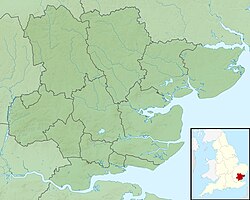History
Captain Comarque was a French Huguenot refugee who, along with a number of others, settled in Thorpe-le-Soken in the early 18th century. Historic England confirms that he was resident in the area in 1717 but that he did not build the house. [1] Pevsner notes the attribution to Sir Robert Taylor, an architect who worked mainly in London and the South-East of England. The building carries a brick datestone for 1755, with the name W. Whatey, who was probably the main building contractor for the house. [1] Local tradition suggests that the house was the childhood home of Clement Attlee, later prime minister, having been bought by his father, Henry, in the late 19th century. [3] Clement Attlee's most recent biographer, John Bew, records Henry Attlee as buying the estate in 1898, while Roy Jenkins in his biography of Attlee dates the purchase to 1897, and the draft Victoria County History for Essex records Henry Attlee as owner from 1898 to 1906. [6] [1] Historic England notes that Attlee's official biographer, Kenneth Harris, did not support the claim, and suggests that Henry Attlee was involved in the sale of the estate rather than its purchase. Kelly's Directory for Essex records Henry Attlee as occupying the property in 1899 [7] and 1901. [8]
In 1913, Comarques was bought by Arnold Bennett, then one of England's most successful novelists, from his considerable literary earnings. [9] Soon after the purchase, Bennett wrote to an American correspondent; "we now possess an early Queen Anne house near the Essex coast and in February are going to install ourselves there definitely for everlasting". During his tenure, which lasted until his separation from his wife in 1921, Bennett amassed a considerable art collection, which was displayed at the house. [a] [12]
The estate was later owned by Albert Fairfax, 12th Lord Fairfax of Cameron. [13] In 2010 the house was on the market. [14] [15]
This page is based on this
Wikipedia article Text is available under the
CC BY-SA 4.0 license; additional terms may apply.
Images, videos and audio are available under their respective licenses.
